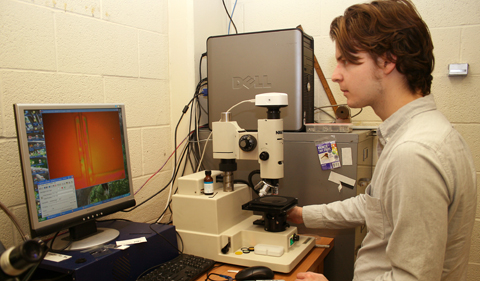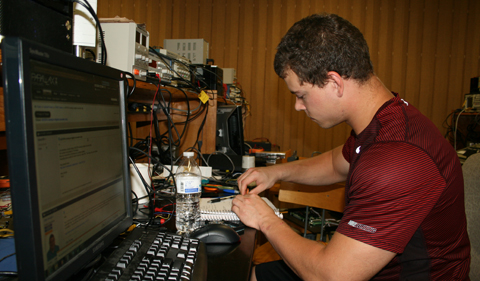Dr. Eric Stinaff, Associate Professor of Physics & Astronomy, is seeking an undergraduate research apprentice for a project on “SpectraSounds: Exploring Color, Light and Sound.”
Currently enrolled Ohio University undergraduates from all colleges are invited to apply for the Research Apprenticeship Program. Administered by the Honors Tutorial College and sponsored by several other units across campus, the program enables students to build skills in research and creative activity by supporting faculty projects. Selected students are paid $10 an hour and agree to work during the time period specified in the description.
This apprenticeship is for 28 hours a week for 12 weeks of Summer 2016.
How to Apply
Applications are due by March 18, 2016. To apply for apprenticeship(s), a student must e-mail Dr. Eric Stinaff. Contact information is listed in the apprenticeship description. The email should explain the student’s qualifications and interest in the project (no more than three paragraphs) and have an attached resume. It is strongly recommended that students meet with an adviser in the Career and Leadership Development Center in Baker Center 533 to help them compose their letter and resume before applying. Late applications will not be accepted. Notification will occur by April 15, 2016. For more information about the application process, contact Laura Schaeffer, Director of Honors Enrichment Programs at schaeffe@ohio.edu or 593-2725. Students may apply for as many apprenticeships as they wish.
Project Description
The purpose of this project is to develop and distribute a new software tool to explore the properties of light and sound by allowing users to “hear” an optical spectrum. Common to both light and sound are the concepts of frequency and wavelength, whereas for light we associate frequency with color, for sound it is the pitch or tone. Making a tangible connection between how we see and hear will open a new playground of opportunities for discovery and creative expression. This project will result in a simple, user-friendly, software tool that will provide a user with an intuitive mapping of frequencies of the optical spectra of elements in the periodic table to audible frequencies. The final product will allow the user a certain degree of freedom in aspects such as the mapping, tone duration, and envelope of the tone’s wave. Upon completion of this project, an open-source program will be made freely available to the public to experiment with. The concept will be ported from the current LabVIEW implementation to a more common, and universal, language to provide support for as many platforms as possible (Mac, Windows, Web based, mobile, etc.). A powerful aspect of this project is its simplicity. mapping between optical and audible frequencies, which can open up a world of exciting new possibilities. For example, we will explore the inverse question, what color is a sound? What would a Beethoven piece look like (Eine Klein.e Nachtmusik to Eine Kleine Lichtmusik )? One could even imagine adapting the tool in such a way that someone with a visual impairment would be able to hear a painting. With the basic engine developed in this program, for converting between color wavelength-frequency-tone, ideas such as these become possible.
Student Contribution to Project
The student will be responsible for writing, testing and documenting the code. They will also lead the beta testing part of the project, which will include getting test clients set up with the software and interacting with them with regards to issues such as bug reports, interface design and potential enhancements.
Desired Qualifications for Apprentice
Solid background in programming.



















Comments